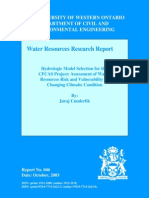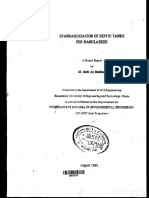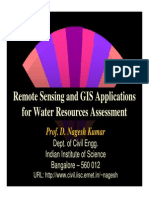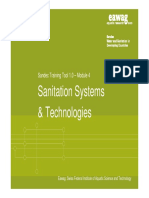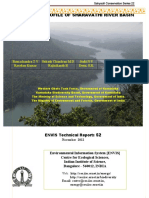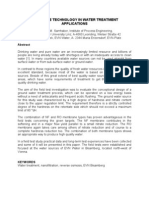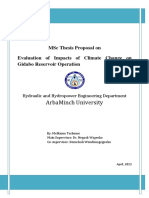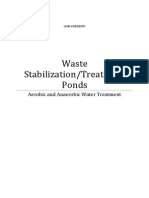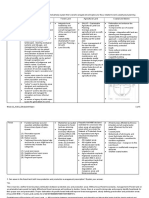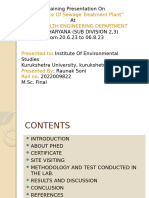Soil and Water Assessment Tool (SWAT) Modelling A Review
Soil and Water Assessment Tool (SWAT) Modelling A Review
Copyright:
Available Formats
Soil and Water Assessment Tool (SWAT) Modelling A Review
Soil and Water Assessment Tool (SWAT) Modelling A Review
Original Title
Copyright
Available Formats
Share this document
Did you find this document useful?
Is this content inappropriate?
Copyright:
Available Formats
Soil and Water Assessment Tool (SWAT) Modelling A Review
Soil and Water Assessment Tool (SWAT) Modelling A Review
Copyright:
Available Formats
Volume 6, Issue 8, August – 2021 International Journal of Innovative Science and Research Technology
ISSN No:-2456-2165
Soil and Water Assessment Tool (SWAT) Modelling:
A Review
Noopur Awasthi1, Munendra Kumar 2,
1
Student, Department of Civil Engineering, Delhi Technological University, New Delhi, India
2
Professor, Department of Civil Engineering, Delhi Technological University, New Delhi, India
Abstract:- In the recent years human activities and almost identical properties, the simulation results of which
climate change affected the hydrological cycle under the are closer to authenticity [2,3].
shifting environmental conditions worldwide and
dispersed hydrological modelling based on practical The essential responsibilities of water resources
methods have become the key topic for hydrological research under changing environment are to objectively
research. There are so many hydrological tools are evaluate the periodicity and randomness of the water cycle
developed to predict the future patterns by analyzing the and quantitatively recognize the aids and modes of natural
historical data. Soil & Water Assessment Tool (SWAT) and artificial factors that drive the evolution of water cycle,
model is one of the distinctive distributed hydrological reproduce the historical process of the water cycle to predict
models which has been extensively used in hydrological the future, and serve water resources regulation and control
research and to predict the future streamflow of rivers decision-making. The distributed hydrological model can
and sediment flow and agricultural production. This quantitatively pronounce the process of hydrological
paper aims to analyze the research progress based on Soil elements and is an effective technical way to identify the
& Water Assessment Tool in recent years. This paper evolution law of water cycle. It is of great significance for the
focused on some prevailing glitches, sought the future rational development, utilization and management of water
research areas, and anticipated model enhancement to resources [4].
acclimate to the local environmental variations. This
study should be beneficial to beginners in the field of The Soil and Water Assessment Tool (SWAT) was
SWAT modelling and also should be valuable for future established to forecast the variation in the quantity and
development of SWAT models. It will also provide quality of water, sediment yield, chemical and pollution level
reference for users of SWAT modelling in related subject. of water in different sources of water due to different types of
water management practices across the globe. Due to its
Keywords:- Climate Change, Hydrological Modelling, Soil & prediction efficiency this model has been used by all over the
Water Assessment Tool (SWAT). world for water management and various hydrological
research applications. After the successful development of a
I. INTRODUCTION SWAT model, it is calibrated with actual data and validated
for future prediction. A number of methods are available for
Hydrological modelling has been used globally as a calibration and validation of the SWAT model. The
commanding tool for water resources research and Sequential Uncertainty Fitting-Version 2 (SUFI-2) algorithm
management. Many researchers have focused on hydrological is mostly used technique for the calibration and validation
modelling of the areas that have experienced an enlarged analysis of a SWAT model [5]. The established results of the
frequency of extreme events i.e. drought and flood. Over SUFI-2 indicate the efficiency of SWAT model and
recent decades, hydrological modelling has facilitated in the integrated SWAT model helps in simulation of streamflow
enhancement of the conservation and sustainable use of water and sediment yield.
resources as well as other natural resources, exclusively
through researches on impacts of land use/land cover II. OBJECTIVE OF THE STUDY
changes, mitigation of climate change and water pollution
[1]. The primary objectives of this study are: (1) to
summarize the structure and principle of SWAT model, and
The hydrological modelling principally includes (2) to analyse the existing problems in the development of
empirical models, conceptual models and physically based SWAT model based on previous published literatures and the
models. Due to the boosted impact of human activities and summary of the application status of SWAT model both at
climate change on the environment, the underlying surface home and abroad in recent years.
changes significantly, more extreme precipitation and
temperature events happened, and conceptual models could The results of this study will help the beginners of
not reflect the change of runoff and nutrients caused by the hydrological modelling to thoroughly understand the SWAT
spatial difference of the underlying surface. But distributed model and its data inputs, structure and applications. It will
models divide the whole watershed into small units with also provide reference for further enhancement of the SWAT
model.
IJISRT21AUG479 www.ijisrt.com 1084
Volume 6, Issue 8, August – 2021 International Journal of Innovative Science and Research Technology
ISSN No:-2456-2165
III. SWAT MODEL DESCRIPTION The SCS curve number is defined with the subsequent
equation:
SWAT model is developed by the USDA Agriculture
Research Service (USDA-ARS), and it is a semi-distributed
model of watershed scale and continuous time [6]. SWAT
officially launched the original SWAT 94.2 version in the
early 1990s, and has been constantly updated and upgraded
till now. The latest version is SWAT 2012
(https://swat.tamu.edu/). The source code of SWAT model is Where:
available online for free. Functioning of SWAT model is Q: Runoff depth in mm
based on daily time step. The main objective to develop P: Effective precipitation mm)
SWAT was to predict the impact of various activities i.e. land S: Maximum potential retention
use/ land cover change, climate change over the years on Ia: Initial abstraction of water in (mm)
stream flow of gauged and ungauged watersheds and water Ia is the function of Maximum potential retention
quality parameters. SWAT simulation process entirely can be
divided into two major parts the land surface which includes Therefore,
runoff and slope confluence and the water surface which Ia = λ S
contains concentration of channel. The SWAT input contains Where:
the meteorological data (Temperature, rainfall, windspeed λ=0.2. Therefore, Ia=0.2 S
etc.) and LULC map, slope map of the watershed. The SWAT Hence, by integrating both Eqs. we have;
model simulates infiltration, percolation, plant growth,
runoff, and nutrient loads to enumerate the effects of climate
change, land use and water management. The major
advantage of SWAT model is that it proficient of constant
simulation over a long period as much as 100 years. SWAT
processes all the input data and determines the movement of
water, sediment and other substances from the river network The runoff occurs when the value of P is greater than
to the basin and the calculate the load [7,8]. 0.5 S. Maximum retention potential of S is accompanying to
the unitless parameter SCS curve number (CN) using the
In the SWAT modelling the bigger watersheds are following equation.
further divided into small catchment areas which are known
as sub basins and sub basins are further divided into smaller
unit which have identical features are known as the
Hydrologic Response Units (HRU’s). Modified SCS curve
The SCS curve number (CN) is subjected with
number and Green-Ampt infiltration method are two methods
permeability of soil, land use, soil–water conditions and
which SWAT use for simulating the streamflow or surface
infiltration. The SCS curve number value can be described by
runoff. Penman-Monteith method, Hargreaves method and
the three conditions (wet, moist, and dry). The SWAT output
Priestley-Taylor method are the three methods which are used
by SWAT to calculate the potential evapotranspiration. develop and validate various parameters i.e., streamflow,
surface runoff, evapotranspiration, reservoir water balance,
Lateral flow is simulated by the kinematic storage model
deep aquifer, interception storage and infiltration [11].
[10]. Shallow aquifer is used for simulation of the return
flow. Water balance equation of SWAT model which directs
the hydrological balance is expressed as: The model simulation results are generally evaluated
using the regression correlation coefficient (R2), Nash-
Sutcliffe modelling efficiency (NSE). Generally, if R2 >0.6,
NSE>0.5, the simulation accuracy of the model meets the
requirements, that is, the SWAT model is suitable to simulate
the watershed [12].
Where:
SWt: Final water content of the soil
SW0: Initial water content of the soil on ith day
Qsurf: ith day surface runoff
Rday: Precipitation ith day precipitation
Ea: ith day evapotranspiration
Wgw: ith day return flow
Wseep: Seepage water on day i
All the parameters are in mm
IJISRT21AUG479 www.ijisrt.com 1085
Volume 6, Issue 8, August – 2021 International Journal of Innovative Science and Research Technology
ISSN No:-2456-2165
V. IMPACT OF CLIMATE CHANGE ON WATER
RESOURCES
“Hydrological cycle research under changing
environment (i.e. global climate change and human activity
influence)” is the core scientific issue of Global Water
Systems Programme (GWSP). Land Use and Land Cover
(LULC) Change is an important manifestation of “changing
environment” [16]. The combination of water cycle and the
terrestrial carbon cycle is a new cross-direction. The scenario
analysis research methods of LULC hydrological impacts
usually include reference comparison method, historical
inversion method, model prediction method, extreme land use
method, and land use spatial allocation method. At present,
many scholars have applied the SWAT model in different
watersheds to analyse the impact of climate change and
confirmed the adaptability and credibility of SWAT model
[17].
Figure 1. The hydrological cycle process of SWAT model. VI. DISCUSSION
SWAT is widely used in many aspects of water cycle
simulation, but it still has certain limitations. For the current
era of big data, there are still some problems and
improvements in the application of SWAT.
Time scale problem
In the application process of SWAT model, most
scholars used the year, season or month as the time scale for
simulation and analysis, and rarely took day as the time step
to simulate. The result is mostly consistent with that of
previous study that SWAT can effectively simulate the
hydrological process of long time series, but the simulation
accuracy decreased with the shortening of time step,
Figure 2: SWAT Model Input and Output
especially the simulation of daily runoff has systematic errors
[18].
IV. RUNOFF SIMULATION
Runoff is the product of the combination of various Uncertainty analysis issues
natural and geographical factors such as climate and SWAT was proposed by American scholars. The data
underlying surface in the basin. Runoff simulation is a used in the model, such as land use types and soil types, are
all based on the localization of the United States. Chinese
significant part of hydrological simulation research and the
basis for studying other hydrological problems [13]. The scholars need to establish attribute database according to the
runoff simulation is mainly divided into two stages. The first land use types and soil characteristics in the study area when
part is to determine the parameters in the model based on applying the model, which is the main reason for the low
historical data of a certain length, and the second one is to use simulation accuracy of the model for the research area with
the model to simulate the runoff of the verification period or incomplete data. And the input of parameters also has some
predict the future runoff. The runoff simulation is mainly uncertainty on the simulation accuracy. At present, many
composed of surface runoff, evapotranspiration, soil water scholars have done a lot of research on sensitivity analysis
and groundwater [14]. The methods for calculating surface and uncertainty analysis of parameters [19].
runoff are Soil Conservation Service Curve Number (SCS-
CN) method and Green-Ampt infiltration method. Generally, Model updating problem
the former is used more frequently. In the literature related to Under changing environment, the relationship between
runoff simulation scholars applied SWAT to runoff rainfall and runoff is non-stationary, and real-time dynamic
simulation which are no longer just the simple application of runoff simulation is required. The current SWAT model
the model in recent years. Foreign scholars are more needs to use the latest data for calibration to make the
concentrated on studies of influencing factors of simulation prediction result more accurate when new data are added,
accuracy [15]. which forms a mechanism of constraint and feedback
between the latest data and future prediction data. But this
method is time consuming and laborious. In the future
research, an algorithm can be added on the basis of the
SWAT model source code, so that the calibration process
IJISRT21AUG479 www.ijisrt.com 1086
Volume 6, Issue 8, August – 2021 International Journal of Innovative Science and Research Technology
ISSN No:-2456-2165
becomes a self-learning process of the model, and the model [10]. Borah, D. K., et al. "Sediment and nutrient modeling for
opens the self-learning mode while the latest data enters the TMDL development and implementation." Transactions
database, which can be self-calibrated for more accurate of the ASABE, 49.4, 967-986, 2006.
simulation [20]. [11]. Castilla-Rho, Juan Carlos, et al. "Sustainable
groundwater management: How long and what will it
VII. CONCLUSIONS take?" Global Environmental Change, 58, 101972,
2019.
The wide application of SWAT model at both domestic [12]. Chahine, Moustafa T. "The hydrological cycle and its
and abroad has confirmed that it is a powerful and influence on climate." Nature, 359.6394, 373-380,
comprehensive hydrological modelling tool. At present, 1992.
domestic and foreign studies on this model mainly focus on [13]. Chambel-Leitão, P., et al. "Coupling SWAT and
model application, model accuracy and model coupling. The tempQsim Mohid River Network." Geophysical
application field of the model are still mainly runoff Research Abstracts, Vol. 8., 2006.
simulation, climate change and water pollution. But the [14]. Hargreaves, George H., and Zohrab A. Samani.
research content is no longer the simple application of the "Reference crop evapotranspiration from
model. The main research contents of runoff simulation are temperature." Applied engineering in agriculture, 1.2,
the study on model accuracy, such as the influence of DEM 96-99, 1985.
resolution and other factors on the simulation accuracy, and [15]. Jain, Sharad K., and V. P. Singh. "Hydrological cycles,
the adaptability of the model in special areas. In order to models and applications to forecasting." Handbook of
adapt to the changing environment, SWAT model still has Hydrometeorological Ensemble Forecasting, 2017.
many directions for improvement, so as to better simulate the [16]. Kumar, Rakesh, R. D. Singh, and K. D. Sharma. "Water
water cycle, serve water resources scheduling decisions, and resources of India." Current science, 794-811, 2005.
provide support for water resources management. [17]. Mausbach, Maurice J., and Allen R. Dedrick. "The
length we go measuring environmental benefits of
REFERENCES conservation practices.", 2004.
[18]. Neitsch, Susan L. "Soil and water assessment
[1]. Abbaspour, K.C.; Faramarzi, M.; Ghasemi, S.S., and tool." User's Manual Version 2005, 476, 2005.
Yang, H., “Assessing the impact of climate change on [19]. Wani, Suhas P., and Kaushal K. Garg. "Watershed
water resources in Iran,” Water Resource Research, management concept and principles." 1-11, 2019.
45(10), [20]. Xu, Jianhua, et al. "Climate change and its effects on
[2]. Arnold, J.G.; Srinivasan, R.; Muttiah, R.S., and runoff of Kaidu River, Xinjiang, China: a multiple time-
Williams, J.R., “Large-area hydrologic modeling and scale analysis." Chinese Geographical Science, 18.4,
assessment: Part I model development”, American 331-339, 2008
Water Resources Association, 34, 73-89, 1998.
[3]. Gassman, Philip W., et al. "The soil and water
assessment tool: historical development, applications,
and future research directions." Transactions of the
ASABE, 50.4, 1211-1250, 2007.
[4]. Alcamo, Joseph, Martina Flörke, and Michael Märker.
"Future long-term changes in global water resources
driven by socio-economic and climatic
changes." Hydrological Sciences Journal, 52.2, 247-
275, 2007.
[5]. Armitage, Peter, C. K. McPherson, and B. C. Rowe.
"Repeated significance tests on accumulating
data." Journal of the Royal Statistical Society: Series A
(General), 132.2, 235-244, 1969.
[6]. Baymani-Nezhad, M., and D. Han. "Hydrological
modeling using effective rainfall routed by the
Muskingum method (ERM)." Journal of Hydro
informatics, 15.4, 1437-1455, 2013
[7]. Benham, Brian L., et al. "Modeling bacteria fate and
transport in watersheds to support
TMDLs." Transactions of the ASABE, 49.4, 987-1002,
2006.
[8]. Beven, Keith J. “Rainfall-runoff modelling: the
primer”. John Wiley & Sons, 2011.
[9]. Beven, Keith. "Causal models as multiple working
hypotheses about environmental processes." Comptes
rendus geoscience, 344.2, 77-88, 2012.
IJISRT21AUG479 www.ijisrt.com 1087
You might also like
- Using The Soil and Water Assessment Tool (SWAT) To Assess Land Use Impact On Water Resources in An East African WatershedNo ratings yetUsing The Soil and Water Assessment Tool (SWAT) To Assess Land Use Impact On Water Resources in An East African Watershed12 pages
- Application of SWAT in Natural Wetland CatchmentsNo ratings yetApplication of SWAT in Natural Wetland Catchments13 pages
- Anaerobic Digestion Technology in Poultry and Livestock Waste Treatment A Literature Review PDFNo ratings yetAnaerobic Digestion Technology in Poultry and Livestock Waste Treatment A Literature Review PDF17 pages
- Anaerobic Pre-Treatment of PharmaceuticalNo ratings yetAnaerobic Pre-Treatment of Pharmaceutical6 pages
- Effects of Bio-Carriers On Membrane Fouling Mitigation in Moving Bed MBRNo ratings yetEffects of Bio-Carriers On Membrane Fouling Mitigation in Moving Bed MBR9 pages
- Bioremediation of Textile Dyes by Fungal-Bacterial BiofilmsNo ratings yetBioremediation of Textile Dyes by Fungal-Bacterial Biofilms8 pages
- EAWAG SANDEC 2008 Module 4 Sanitation Systems and Technologies - PresentationNo ratings yetEAWAG SANDEC 2008 Module 4 Sanitation Systems and Technologies - Presentation61 pages
- Aeration: ENVE 301 Environmental Engineering Unit OperationsNo ratings yetAeration: ENVE 301 Environmental Engineering Unit Operations37 pages
- Biostimulasi Dan Bioaugmentasi Untuk Bioremediasi Limbah Hidrokarbon100% (1)Biostimulasi Dan Bioaugmentasi Untuk Bioremediasi Limbah Hidrokarbon115 pages
- (Report) Ecological Profile of Sharavathi River Basin100% (1)(Report) Ecological Profile of Sharavathi River Basin160 pages
- Drinking Water Treatment Residuals - A Review of Recent UsesNo ratings yetDrinking Water Treatment Residuals - A Review of Recent Uses12 pages
- Settlement and Stresses Multi Layer SoilNo ratings yetSettlement and Stresses Multi Layer Soil35 pages
- Principles and Practices of Reverse OsmosisNo ratings yetPrinciples and Practices of Reverse Osmosis9 pages
- On Site Sewage Treatment (Alternative Waste Systems)No ratings yetOn Site Sewage Treatment (Alternative Waste Systems)6 pages
- Critical Review of Desalination ConcentrNo ratings yetCritical Review of Desalination Concentr13 pages
- Water Resources Management in A Changing WorldNo ratings yetWater Resources Management in A Changing World6 pages
- Water Quality Index Mapping of Kengeri Industrial Area of Bangalore City Using Geospatial AnalysisNo ratings yetWater Quality Index Mapping of Kengeri Industrial Area of Bangalore City Using Geospatial Analysis7 pages
- ICE Annex A Methodologies For RecyclingNo ratings yetICE Annex A Methodologies For Recycling17 pages
- Membrane Technology in Water Treatment ApplicationsNo ratings yetMembrane Technology in Water Treatment Applications11 pages
- Aquifer Systems Management Darcy's Legacy in A World of Impending Water ShortageNo ratings yetAquifer Systems Management Darcy's Legacy in A World of Impending Water Shortage610 pages
- Assessment of Water Quality Index of Industrial Area Surface Water SamplesNo ratings yetAssessment of Water Quality Index of Industrial Area Surface Water Samples6 pages
- Decentralized Approaches To Wastewater TreatmentNo ratings yetDecentralized Approaches To Wastewater Treatment8 pages
- Giz Grey Water Recycling and Reuse 2011No ratings yetGiz Grey Water Recycling and Reuse 201194 pages
- ANOVA and Simple Comparative ExperimentNo ratings yetANOVA and Simple Comparative Experiment44 pages
- Modeling Stream Flow Using SWAT Model InNo ratings yetModeling Stream Flow Using SWAT Model In20 pages
- A Study on Investor Decision Making and Buying Motives on Gold InvestmentNo ratings yetA Study on Investor Decision Making and Buying Motives on Gold Investment4 pages
- Contribution of Agency Banking to the Growth of Economic Activities in Cross River State, NigeriaNo ratings yetContribution of Agency Banking to the Growth of Economic Activities in Cross River State, Nigeria6 pages
- Enhancing Regression Diagnostics: Automated Residual Analysis Using Computer Vision and Statistical InsightsNo ratings yetEnhancing Regression Diagnostics: Automated Residual Analysis Using Computer Vision and Statistical Insights10 pages
- Helfine: Real-Time Helmet Violation Detection with Automated Fine SystemNo ratings yetHelfine: Real-Time Helmet Violation Detection with Automated Fine System8 pages
- Geographical Appraisal on Spatial Pattern of the Declassification Trends among Census Towns in West BengalNo ratings yetGeographical Appraisal on Spatial Pattern of the Declassification Trends among Census Towns in West Bengal20 pages
- Enhancing Customer Satisfaction in Nepalese Banks and Financial Institutions: The Influence of Service Quality on Different DimensionsNo ratings yetEnhancing Customer Satisfaction in Nepalese Banks and Financial Institutions: The Influence of Service Quality on Different Dimensions11 pages
- Effects of Entrepreneurship and Entrepreneurial Mentorship in the Promotion of Economic Development in NigeriaNo ratings yetEffects of Entrepreneurship and Entrepreneurial Mentorship in the Promotion of Economic Development in Nigeria7 pages
- Security Staffing Strategic Plan for Organizations Security Posture EnhancementNo ratings yetSecurity Staffing Strategic Plan for Organizations Security Posture Enhancement8 pages
- Stroke Prediction using Machine LearningNo ratings yetStroke Prediction using Machine Learning6 pages
- Assessment of Heavy Metals in Ambient Air in the Patancheru Area, Sangareddy District, TelanganaNo ratings yetAssessment of Heavy Metals in Ambient Air in the Patancheru Area, Sangareddy District, Telangana16 pages
- Smart Farming System with Cloud AnalyticsNo ratings yetSmart Farming System with Cloud Analytics10 pages
- A Participatory Evaluation of Child Labor in the Shea Value Chain in Northern GhanaNo ratings yetA Participatory Evaluation of Child Labor in the Shea Value Chain in Northern Ghana11 pages
- A Study on Optimizing Supply Chain Resilience: Emergency Parts Ordering AnalysisNo ratings yetA Study on Optimizing Supply Chain Resilience: Emergency Parts Ordering Analysis6 pages
- Adolescent Girls’ Knowledge Regarding Menstrual Hygiene at Institute of Public Health School and College, Mohakhali, DhakaNo ratings yetAdolescent Girls’ Knowledge Regarding Menstrual Hygiene at Institute of Public Health School and College, Mohakhali, Dhaka11 pages
- A Research on Labor, Finance, Technology, and Sustainable GrowthNo ratings yetA Research on Labor, Finance, Technology, and Sustainable Growth28 pages
- Analysis of Components for BPR Implementation in the Public Sector, Focusing on Online Service Delivery in TanzaniaNo ratings yetAnalysis of Components for BPR Implementation in the Public Sector, Focusing on Online Service Delivery in Tanzania16 pages
- An In-Depth Review of Secretome Therapy Approaches in Medical Practice Secretome Therapy in MedicineNo ratings yetAn In-Depth Review of Secretome Therapy Approaches in Medical Practice Secretome Therapy in Medicine6 pages
- The Non-Linear Impact of Natural Gas Production on Nigeria’s Industrial Sector: Unraveling the Growth Paradox and Investment DynamicsNo ratings yetThe Non-Linear Impact of Natural Gas Production on Nigeria’s Industrial Sector: Unraveling the Growth Paradox and Investment Dynamics11 pages
- Maternal and Fetal Outcomes after Emergency Caesarian Sections at Bashair Teaching Hospital, Khartoum State, Sudan, 2022No ratings yetMaternal and Fetal Outcomes after Emergency Caesarian Sections at Bashair Teaching Hospital, Khartoum State, Sudan, 202211 pages
- Statistical Models for Prediction of Treatment Response Patterns among Diverse Ethnic Populations with Breast CancerNo ratings yetStatistical Models for Prediction of Treatment Response Patterns among Diverse Ethnic Populations with Breast Cancer28 pages
- Revolutionizing Beer Quality Control: Rapid Microbial Identification Via Nanopore SequencingNo ratings yetRevolutionizing Beer Quality Control: Rapid Microbial Identification Via Nanopore Sequencing6 pages
- Women Leadership, Transformation and Cultural Conflict: Evidence from the LiteratureNo ratings yetWomen Leadership, Transformation and Cultural Conflict: Evidence from the Literature25 pages
- The Role of Paradigm Shifts in Scientific Innovation: Analysis of Kuhn’s Concept of Scientific Revolutions with Modern Case StudiesNo ratings yetThe Role of Paradigm Shifts in Scientific Innovation: Analysis of Kuhn’s Concept of Scientific Revolutions with Modern Case Studies9 pages
- Polyculture Pond Business Development Strategy in Cantigi Sub-District, Indramayu Regency, West JavaNo ratings yetPolyculture Pond Business Development Strategy in Cantigi Sub-District, Indramayu Regency, West Java12 pages
- The Role of Ethical Hacking and AI in Proactive Cyber Defense: Current Approaches and Future PerspectivesNo ratings yetThe Role of Ethical Hacking and AI in Proactive Cyber Defense: Current Approaches and Future Perspectives8 pages
- Evaluating the Computational Efficiency and Precision of Pathfinding AlgorithmsNo ratings yetEvaluating the Computational Efficiency and Precision of Pathfinding Algorithms8 pages
- Factors Influencing Uptake of Sexual Reproductive Health Services Among Female Students at Maseno University KenyaNo ratings yetFactors Influencing Uptake of Sexual Reproductive Health Services Among Female Students at Maseno University Kenya13 pages
- Adolescence Emotional Separation and Detachment from ParentsNo ratings yetAdolescence Emotional Separation and Detachment from Parents3 pages
- Comparison of Sonographic Features, FNAC, and Histopathological Findings in Patients with Thyroid Swelling100% (1)Comparison of Sonographic Features, FNAC, and Histopathological Findings in Patients with Thyroid Swelling6 pages
- Assessment of Farmers Local Knowledge on the Effect of Indigenous Agro Forestry Practice to Land Degradation Management a case Study of Chelia District, West Shoa Zone, Oromia Region, Ethiopia100% (1)Assessment of Farmers Local Knowledge on the Effect of Indigenous Agro Forestry Practice to Land Degradation Management a case Study of Chelia District, West Shoa Zone, Oromia Region, Ethiopia12 pages
- Ecological Footprints : A Measure of Human Demand On The Earth'sNo ratings yetEcological Footprints : A Measure of Human Demand On The Earth's28 pages
- Enhancing Future Resilience in Urban Drainage System - Green Versus Grey100% (1)Enhancing Future Resilience in Urban Drainage System - Green Versus Grey38 pages
- Water Conservation Education Programs: EPD Guidance DocumentNo ratings yetWater Conservation Education Programs: EPD Guidance Document16 pages
- Engineering Utilities 2 Midterm Exam ReviewerNo ratings yetEngineering Utilities 2 Midterm Exam Reviewer1 page
- Conserving Biodiversity International Efforts PDFNo ratings yetConserving Biodiversity International Efforts PDF7 pages
- (Water Science and Technology Library 57) Sharad K. Jain, Pushpendra K. Agarwal, Vijay P. Singh (Auth.) - Hydrology and Water Resources of India-Springer Netherlands (2007)No ratings yet(Water Science and Technology Library 57) Sharad K. Jain, Pushpendra K. Agarwal, Vijay P. Singh (Auth.) - Hydrology and Water Resources of India-Springer Netherlands (2007)1,277 pages
- Waste Water Recycling System-Effluent SystemNo ratings yetWaste Water Recycling System-Effluent System15 pages
- Prepared For Bin Garallah Contracting Co: Technical & Commerical ProposalNo ratings yetPrepared For Bin Garallah Contracting Co: Technical & Commerical Proposal12 pages
- Micro Project Report: Roll No Name of Student ProgrammeNo ratings yetMicro Project Report: Roll No Name of Student Programme14 pages
- Week 11 - P203 - CMalolotVillalon-compressed100% (1)Week 11 - P203 - CMalolotVillalon-compressed5 pages
- 5.1 KATALOG Toray - TM800M - v1 - 202201No ratings yet5.1 KATALOG Toray - TM800M - v1 - 2022012 pages
- 4 Design and Operation of Landfills 1667309860593No ratings yet4 Design and Operation of Landfills 166730986059330 pages
- Water Supply and Environmental EngineeringNo ratings yetWater Supply and Environmental Engineering14 pages
- Using The Soil and Water Assessment Tool (SWAT) To Assess Land Use Impact On Water Resources in An East African WatershedUsing The Soil and Water Assessment Tool (SWAT) To Assess Land Use Impact On Water Resources in An East African Watershed
- Anaerobic Digestion Technology in Poultry and Livestock Waste Treatment A Literature Review PDFAnaerobic Digestion Technology in Poultry and Livestock Waste Treatment A Literature Review PDF
- Effects of Bio-Carriers On Membrane Fouling Mitigation in Moving Bed MBREffects of Bio-Carriers On Membrane Fouling Mitigation in Moving Bed MBR
- Bioremediation of Textile Dyes by Fungal-Bacterial BiofilmsBioremediation of Textile Dyes by Fungal-Bacterial Biofilms
- EAWAG SANDEC 2008 Module 4 Sanitation Systems and Technologies - PresentationEAWAG SANDEC 2008 Module 4 Sanitation Systems and Technologies - Presentation
- Aeration: ENVE 301 Environmental Engineering Unit OperationsAeration: ENVE 301 Environmental Engineering Unit Operations
- Biostimulasi Dan Bioaugmentasi Untuk Bioremediasi Limbah HidrokarbonBiostimulasi Dan Bioaugmentasi Untuk Bioremediasi Limbah Hidrokarbon
- (Report) Ecological Profile of Sharavathi River Basin(Report) Ecological Profile of Sharavathi River Basin
- Drinking Water Treatment Residuals - A Review of Recent UsesDrinking Water Treatment Residuals - A Review of Recent Uses
- On Site Sewage Treatment (Alternative Waste Systems)On Site Sewage Treatment (Alternative Waste Systems)
- Water Quality Index Mapping of Kengeri Industrial Area of Bangalore City Using Geospatial AnalysisWater Quality Index Mapping of Kengeri Industrial Area of Bangalore City Using Geospatial Analysis
- Membrane Technology in Water Treatment ApplicationsMembrane Technology in Water Treatment Applications
- Aquifer Systems Management Darcy's Legacy in A World of Impending Water ShortageAquifer Systems Management Darcy's Legacy in A World of Impending Water Shortage
- Assessment of Water Quality Index of Industrial Area Surface Water SamplesAssessment of Water Quality Index of Industrial Area Surface Water Samples
- A Study on Investor Decision Making and Buying Motives on Gold InvestmentA Study on Investor Decision Making and Buying Motives on Gold Investment
- Contribution of Agency Banking to the Growth of Economic Activities in Cross River State, NigeriaContribution of Agency Banking to the Growth of Economic Activities in Cross River State, Nigeria
- Enhancing Regression Diagnostics: Automated Residual Analysis Using Computer Vision and Statistical InsightsEnhancing Regression Diagnostics: Automated Residual Analysis Using Computer Vision and Statistical Insights
- Helfine: Real-Time Helmet Violation Detection with Automated Fine SystemHelfine: Real-Time Helmet Violation Detection with Automated Fine System
- Geographical Appraisal on Spatial Pattern of the Declassification Trends among Census Towns in West BengalGeographical Appraisal on Spatial Pattern of the Declassification Trends among Census Towns in West Bengal
- Enhancing Customer Satisfaction in Nepalese Banks and Financial Institutions: The Influence of Service Quality on Different DimensionsEnhancing Customer Satisfaction in Nepalese Banks and Financial Institutions: The Influence of Service Quality on Different Dimensions
- Effects of Entrepreneurship and Entrepreneurial Mentorship in the Promotion of Economic Development in NigeriaEffects of Entrepreneurship and Entrepreneurial Mentorship in the Promotion of Economic Development in Nigeria
- Security Staffing Strategic Plan for Organizations Security Posture EnhancementSecurity Staffing Strategic Plan for Organizations Security Posture Enhancement
- Assessment of Heavy Metals in Ambient Air in the Patancheru Area, Sangareddy District, TelanganaAssessment of Heavy Metals in Ambient Air in the Patancheru Area, Sangareddy District, Telangana
- A Participatory Evaluation of Child Labor in the Shea Value Chain in Northern GhanaA Participatory Evaluation of Child Labor in the Shea Value Chain in Northern Ghana
- A Study on Optimizing Supply Chain Resilience: Emergency Parts Ordering AnalysisA Study on Optimizing Supply Chain Resilience: Emergency Parts Ordering Analysis
- Adolescent Girls’ Knowledge Regarding Menstrual Hygiene at Institute of Public Health School and College, Mohakhali, DhakaAdolescent Girls’ Knowledge Regarding Menstrual Hygiene at Institute of Public Health School and College, Mohakhali, Dhaka
- A Research on Labor, Finance, Technology, and Sustainable GrowthA Research on Labor, Finance, Technology, and Sustainable Growth
- Analysis of Components for BPR Implementation in the Public Sector, Focusing on Online Service Delivery in TanzaniaAnalysis of Components for BPR Implementation in the Public Sector, Focusing on Online Service Delivery in Tanzania
- An In-Depth Review of Secretome Therapy Approaches in Medical Practice Secretome Therapy in MedicineAn In-Depth Review of Secretome Therapy Approaches in Medical Practice Secretome Therapy in Medicine
- The Non-Linear Impact of Natural Gas Production on Nigeria’s Industrial Sector: Unraveling the Growth Paradox and Investment DynamicsThe Non-Linear Impact of Natural Gas Production on Nigeria’s Industrial Sector: Unraveling the Growth Paradox and Investment Dynamics
- Maternal and Fetal Outcomes after Emergency Caesarian Sections at Bashair Teaching Hospital, Khartoum State, Sudan, 2022Maternal and Fetal Outcomes after Emergency Caesarian Sections at Bashair Teaching Hospital, Khartoum State, Sudan, 2022
- Statistical Models for Prediction of Treatment Response Patterns among Diverse Ethnic Populations with Breast CancerStatistical Models for Prediction of Treatment Response Patterns among Diverse Ethnic Populations with Breast Cancer
- Revolutionizing Beer Quality Control: Rapid Microbial Identification Via Nanopore SequencingRevolutionizing Beer Quality Control: Rapid Microbial Identification Via Nanopore Sequencing
- Women Leadership, Transformation and Cultural Conflict: Evidence from the LiteratureWomen Leadership, Transformation and Cultural Conflict: Evidence from the Literature
- The Role of Paradigm Shifts in Scientific Innovation: Analysis of Kuhn’s Concept of Scientific Revolutions with Modern Case StudiesThe Role of Paradigm Shifts in Scientific Innovation: Analysis of Kuhn’s Concept of Scientific Revolutions with Modern Case Studies
- Polyculture Pond Business Development Strategy in Cantigi Sub-District, Indramayu Regency, West JavaPolyculture Pond Business Development Strategy in Cantigi Sub-District, Indramayu Regency, West Java
- The Role of Ethical Hacking and AI in Proactive Cyber Defense: Current Approaches and Future PerspectivesThe Role of Ethical Hacking and AI in Proactive Cyber Defense: Current Approaches and Future Perspectives
- Evaluating the Computational Efficiency and Precision of Pathfinding AlgorithmsEvaluating the Computational Efficiency and Precision of Pathfinding Algorithms
- Factors Influencing Uptake of Sexual Reproductive Health Services Among Female Students at Maseno University KenyaFactors Influencing Uptake of Sexual Reproductive Health Services Among Female Students at Maseno University Kenya
- Adolescence Emotional Separation and Detachment from ParentsAdolescence Emotional Separation and Detachment from Parents
- Comparison of Sonographic Features, FNAC, and Histopathological Findings in Patients with Thyroid SwellingComparison of Sonographic Features, FNAC, and Histopathological Findings in Patients with Thyroid Swelling
- Assessment of Farmers Local Knowledge on the Effect of Indigenous Agro Forestry Practice to Land Degradation Management a case Study of Chelia District, West Shoa Zone, Oromia Region, EthiopiaAssessment of Farmers Local Knowledge on the Effect of Indigenous Agro Forestry Practice to Land Degradation Management a case Study of Chelia District, West Shoa Zone, Oromia Region, Ethiopia
- Ecological Footprints : A Measure of Human Demand On The Earth'sEcological Footprints : A Measure of Human Demand On The Earth's
- Enhancing Future Resilience in Urban Drainage System - Green Versus GreyEnhancing Future Resilience in Urban Drainage System - Green Versus Grey
- Water Conservation Education Programs: EPD Guidance DocumentWater Conservation Education Programs: EPD Guidance Document
- (Water Science and Technology Library 57) Sharad K. Jain, Pushpendra K. Agarwal, Vijay P. Singh (Auth.) - Hydrology and Water Resources of India-Springer Netherlands (2007)(Water Science and Technology Library 57) Sharad K. Jain, Pushpendra K. Agarwal, Vijay P. Singh (Auth.) - Hydrology and Water Resources of India-Springer Netherlands (2007)
- Prepared For Bin Garallah Contracting Co: Technical & Commerical ProposalPrepared For Bin Garallah Contracting Co: Technical & Commerical Proposal
- Micro Project Report: Roll No Name of Student ProgrammeMicro Project Report: Roll No Name of Student Programme




